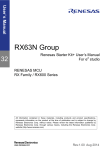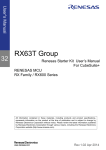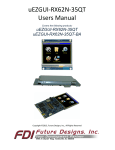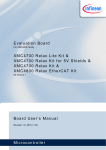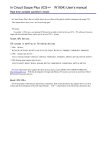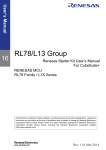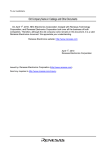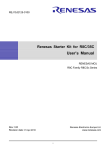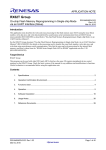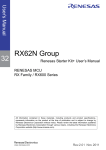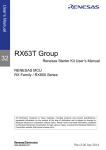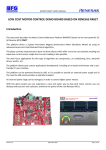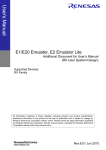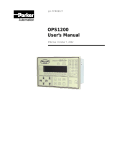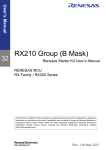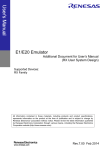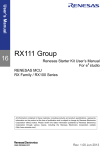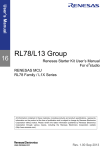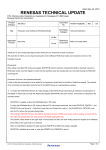Download Renesas Starter Kit for RX62T User`s Manual
Transcript
User’s Manual 32 RX62T Group Renesas Starter Kit User’s Manual RENESAS MCU RX Family / RX600 Series All information contained in these materials, including products and product specifications, represents information on the product at the time of publication and is subject to change by Renesas Electronics Corp. without notice. Please review the latest information published by Renesas Electronics Corp. through various means, including the Renesas Electronics Corp. website (http://www.renesas.com). www.renesas.com Rev.1.00 Oct 2010 Notice 1. 2. 3. 4. 5. 6. 7. All information included in this document is current as of the date this document is issued. Such information, however, is subject to change without any prior notice. Before purchasing or using any Renesas Electronics products listed herein, please confirm the latest product information with a Renesas Electronics sales office. Also, please pay regular and careful attention to additional and different information to be disclosed by Renesas Electronics such as that disclosed through our website. Renesas Electronics does not assume any liability for infringement of patents, copyrights, or other intellectual property rights of third parties by or arising from the use of Renesas Electronics products or technical information described in this document. No license, express, implied or otherwise, is granted hereby under any patents, copyrights or other intellectual property rights of Renesas Electronics or others. You should not alter, modify, copy, or otherwise misappropriate any Renesas Electronics product, whether in whole or in part. Descriptions of circuits, software and other related information in this document are provided only to illustrate the operation of semiconductor products and application examples. You are fully responsible for the incorporation of these circuits, software, and information in the design of your equipment. Renesas Electronics assumes no responsibility for any losses incurred by you or third parties arising from the use of these circuits, software, or information. When exporting the products or technology described in this document, you should comply with the applicable export control laws and regulations and follow the procedures required by such laws and regulations. You should not use Renesas Electronics products or the technology described in this document for any purpose relating to military applications or use by the military, including but not limited to the development of weapons of mass destruction. Renesas Electronics products and technology may not be used for or incorporated into any products or systems whose manufacture, use, or sale is prohibited under any applicable domestic or foreign laws or regulations. Renesas Electronics has used reasonable care in preparing the information included in this document, but Renesas Electronics does not warrant that such information is error free. Renesas Electronics assumes no liability whatsoever for any damages incurred by you resulting from errors in or omissions from the information included herein. Renesas Electronics products are classified according to the following three quality grades: “Standard”, “High Quality”, and “Specific”. The recommended applications for each Renesas Electronics product depends on the product’s quality grade, as indicated below. You must check the quality grade of each Renesas Electronics product before using it in a particular application. You may not use any Renesas Electronics product for any application categorized as “Specific” without the prior written consent of Renesas Electronics. Further, you may not use any Renesas Electronics product for any application for which it is not intended without the prior written consent of Renesas Electronics. Renesas Electronics shall not be in any way liable for any damages or losses incurred by you or third parties arising from the use of any Renesas Electronics product for an application categorized as “Specific” or for which the product is not intended where you have failed to obtain the prior written consent of Renesas Electronics. The quality grade of each Renesas Electronics product is “Standard” unless otherwise expressly specified in a Renesas Electronics data sheets or data books, etc. “Standard”: Computers; office equipment; communications equipment; test and measurement equipment; audio and visual equipment; home electronic appliances; machine tools; personal electronic equipment; and industrial robots. “High Quality”: Transportation equipment (automobiles, trains, ships, etc.); traffic control systems; anti-disaster systems; anticrime systems; safety equipment; and medical equipment not specifically designed for life support. “Specific”: Aircraft; aerospace equipment; submersible repeaters; nuclear reactor control systems; medical equipment or systems for life support (e.g. artificial life support devices or systems), surgical implantations, or healthcare intervention (e.g. excision, etc.), and any other applications or purposes that pose a direct threat to human life. 8. You should use the Renesas Electronics products described in this document within the range specified by Renesas Electronics, especially with respect to the maximum rating, operating supply voltage range, movement power voltage range, heat radiation characteristics, installation and other product characteristics. Renesas Electronics shall have no liability for malfunctions or damages arising out of the use of Renesas Electronics products beyond such specified ranges. 9. Although Renesas Electronics endeavors to improve the quality and reliability of its products, semiconductor products have specific characteristics such as the occurrence of failure at a certain rate and malfunctions under certain use conditions. Further, Renesas Electronics products are not subject to radiation resistance design. Please be sure to implement safety measures to guard them against the possibility of physical injury, and injury or damage caused by fire in the event of the failure of a Renesas Electronics product, such as safety design for hardware and software including but not limited to redundancy, fire control and malfunction prevention, appropriate treatment for aging degradation or any other appropriate measures. Because the evaluation of microcomputer software alone is very difficult, please evaluate the safety of the final products or system manufactured by you. 10. Please contact a Renesas Electronics sales office for details as to environmental matters such as the environmental compatibility of each Renesas Electronics product. Please use Renesas Electronics products in compliance with all applicable laws and regulations that regulate the inclusion or use of controlled substances, including without limitation, the EU RoHS Directive. Renesas Electronics assumes no liability for damages or losses occurring as a result of your noncompliance with applicable laws and regulations. 11. This document may not be reproduced or duplicated, in any form, in whole or in part, without prior written consent of Renesas Electronics. 12. Please contact a Renesas Electronics sales office if you have any questions regarding the information contained in this document or Renesas Electronics products, or if you have any other inquiries. (Note 1) “Renesas Electronics” as used in this document means Renesas Electronics Corporation and also includes its majorityowned subsidiaries. (Note 2) “Renesas Electronics product(s)” means any product developed or manufactured by or for Renesas Electronics. Disclaimer By using this Renesas Starter Kit (RSK), the user accepts the following terms: The RSK is not guaranteed to be error free, and the entire risk as to the results and performance of the RSK is assumed by the User. The RSK is provided by Renesas on an “as is” basis without warranty of any kind whether express or implied, including but not limited to the implied warranties of satisfactory quality, fitness for a particular purpose, title and non-infringement of intellectual property rights with regard to the RSK. Renesas expressly disclaims all such warranties. Renesas or its affiliates shall in no event be liable for any loss of profit, loss of data, loss of contract, loss of business, damage to reputation or goodwill, any economic loss, any reprogramming or recall costs (whether the foregoing losses are direct or indirect) nor shall Renesas or its affiliates be liable for any other direct or indirect special, incidental or consequential damages arising out of or in relation to the use of this RSK, even if Renesas or its affiliates have been advised of the possibility of such damages. Precautions The following precautions should be observed when operating any RSK product: This Renesas Starter Kit is only intended for use in a laboratory environment under ambient temperature and humidity conditions. A safe separation distance should be used between this and any sensitive equipment. Its use outside the laboratory, classroom, study area or similar such area invalidates conformity with the protection requirements of the Electromagnetic Compatibility Directive and could lead to prosecution. The product generates, uses, and can radiate radio frequency energy and may cause harmful interference to radio communications. However, there is no guarantee that interference will not occur in a particular installation. If this equipment causes harmful interference to radio or television reception, which can be determined by turning the equipment off or on, you are encouraged to try to correct the interference by one or more of the following measures; • ensure attached cables do not lie across the equipment • reorient the receiving antenna • increase the distance between the equipment and the receiver • connect the equipment into an outlet on a circuit different from that which the receiver is connected • power down the equipment when not in use • consult the dealer or an experienced radio/TV technician for help NOTE: It is recommended that wherever possible shielded interface cables are used. The product is potentially susceptible to certain EMC phenomena. To mitigate against them it is recommended that the following measures be undertaken; • The user is advised that mobile phones should not be used within 10m of the product when in use. • The user is advised to take ESD precautions when handling the equipment. The Renesas Starter Kit does not represent an ideal reference design for an end product and does not fulfil the regulatory standards for an end product. How to Use This Manual 1. Purpose and Target Readers This manual is designed to provide the user with an understanding of the RSK hardware functionality, and electrical characteristics. It is intended for users designing sample code on the RSK platform, using the many different incorporated peripheral devices. The manual comprises of an overview of the capabilities of the RSK product, but does not intend to be a guide to embedded programming or hardware design. Further details regarding setting up the RSK and development environment can found in the tutorial manual. Particular attention should be paid to the precautionary notes when using the manual. These notes occur within the body of the text, at the end of each section, and in the Usage Notes section. The revision history summarizes the locations of revisions and additions. It does not list all revisions. Refer to the text of the manual for details. The following documents apply to the RX62T Group. Make sure to refer to the latest versions of these documents. The newest versions of the documents listed may be obtained from the Renesas Electronics Web site. Document Type Description Document Title User’s Manual Describes the technical details of the RSK hardware. RSKRX62T User’s Manual REJ10J2194 Software Manual Describes the functionality of the sample code, and its interaction with the Renesas Peripheral Driver Library (RPDL) RSKRX62T Software Manual REJ10J2197 Tutorial Provides a guide to setting up RSK environment, running sample code and debugging programs. RSKRX62T Tutorial Manual REJ10J2195 Quick Start Guide Provides simple instructions to setup the RSK and run the first sample, on a single A4 sheet. RSKRX62T Start Guide REJ10J2196 Schematics Full detail circuit schematics of the RSK. RSKRX62T Schematics RJJ99J0072 Hardware Manual Provides technical microcontroller. RX62T Group Hardware Manual R01UH0034EJ0100 details of the RX62T Quick Document No. 2. List of Abbreviations and Acronyms Abbreviation ADC bps CAN CPU CRC DMA E1 EMC ESD HEW IIC IRQ LCD LED MCU MTU PC PWM RSK RAM SFR UART USB Full Form Analogue-to-Digital Converter bits per second Controller-Area Network Central Processing Unit Cyclic Redundancy Check Direct Memory Access On-chip Debugger Electromagnetic Compatibility Electrostatic Discharge High-performance Embedded Workshop Philips™ Inter-Integrated Circuit connection bus Interrupt Request Liquid Crystal Display Light Emitting Diode Micro-controller Unit Multifunction Timer Unit Program Counter Pulse Width Modulation Renesas Starter Kit Random Access Memory Special Function Register Universal Asynchronous Receiver/Transmitter Universal Serial Bus Table of Contents 1. Overview ............................................................................................................................................ 7 1.1 1.2 Purpose...................................................................................................................................................................... 7 Features ..................................................................................................................................................................... 7 2. Power Supply ..................................................................................................................................... 8 2.1 2.2 Requirements ............................................................................................................................................................ 8 Power-Up Behaviour................................................................................................................................................. 8 3. Board Layout ..................................................................................................................................... 9 3.1 3.2 3.3 Component Layout.................................................................................................................................................... 9 Board Dimensions ................................................................................................................................................... 10 Component Placement .............................................................................................................................................11 4. Connectivity ..................................................................................................................................... 13 4.1 4.2 Internal RSK Connections ...................................................................................................................................... 13 Debugger Connections ............................................................................................................................................ 14 5. User Circuitry................................................................................................................................... 15 5.1 5.2 5.3 5.4 5.5 5.6 5.7 5.8 5.9 Reset Circuit ........................................................................................................................................................... 15 Clock Circuit ........................................................................................................................................................... 15 Switches .................................................................................................................................................................. 15 LEDs ....................................................................................................................................................................... 15 Potentiometer .......................................................................................................................................................... 16 Debug LCD Module ............................................................................................................................................... 16 RS232 Serial Port.................................................................................................................................................... 16 Controller-Area Network (CAN) ............................................................................................................................ 17 Local-Interconnect Network (LIN) ......................................................................................................................... 17 6. Configuration ................................................................................................................................... 18 6.1 6.2 6.3 6.4 6.5 6.6 6.7 6.8 6.9 6.10 Modifying the RSK ................................................................................................................................................. 18 MCU Configuration ................................................................................................................................................ 18 ADC Configuration ................................................................................................................................................. 19 RS232 Serial Port Configuration ............................................................................................................................ 20 LIN Configuration .................................................................................................................................................. 21 CAN Configuration ................................................................................................................................................. 22 IRQ & General I/O Pin Configuration .................................................................................................................... 23 Multi-Function Timer Pulse Unit (MTU) Configuration ........................................................................................ 26 Power Supply Configuration ................................................................................................................................... 26 Clock Configuration................................................................................................................................................ 27 7. Headers ............................................................................................................................................ 28 7.1 7.2 Application Headers................................................................................................................................................ 28 Microcontroller Ring Headers ................................................................................................................................ 30 8. Code Development........................................................................................................................... 34 8.1 8.2 8.3 8.4 8.5 Overview ................................................................................................................................................................. 34 Compiler Restrictions ............................................................................................................................................. 34 Mode Support.......................................................................................................................................................... 34 Debugging Support ................................................................................................................................................. 34 Address Space ......................................................................................................................................................... 35 9. Additional Information..................................................................................................................... 36 RSKRX62T RENESAS STARTER KIT REJ10J2194-0100 Rev.1.00 Oct 10, 2010 1. Overview 1.1 Purpose This RSK is an evaluation tool for Renesas microcontrollers. This manual describes the technical details of the RSK hardware. The Quick Start Guide and Tutorial Manual provide details of the software installation and debugging environment. 1.2 Features This RSK provides an evaluation of the following features: • Renesas microcontroller programming • User code debugging • User circuitry such as switches, LEDs and a potentiometer • Sample application • Sample peripheral device initialisation code The RSK board contains all the circuitry required for microcontroller operation. REJ10J2194-0100 Rev. 1.00 Oct 10, 2010 Page 7 of 40 RSKRX62T 2. Power Supply 2. Power Supply 2.1 Requirements This RSK is supplied with an E1 debugger. The debugger is able to power the RSK board with up to 200mA. When the RSK is connected to another system then that system should supply power to the RSK. All RSK and RSK+ boards have an optional centre positive supply connector using a 2.0mm barrel power jack. This RSK supports one voltage input. Details of the external power supply connection are shown in Table 2-1 below. Connector PWR Supply Voltages Regulated, 5V DC J13 Setting Do Not Fit J14 Setting Do Not Fit Table 2-1: Main Power Supply Requirements This RSK should only be supplied with a regulated power supply. 2.2 Power-Up Behaviour When the RSK is purchased, the RSK board has the ‘Release’ or stand-alone code from the example tutorial code pre-programmed into the Renesas microcontroller. On powering up the board the user LEDs will start to flash. After 200 flashes or after pressing any switch, the LEDs will flash at a rate controlled by the potentiometer. REJ10J2194-0100 Rev. 1.00 Oct 10, 2010 Page 8 of 40 RSKRX62T 3. Board Layout 3. Board Layout 3.1 Component Layout J2 J4 Figure 3-1 below shows the top component layout of the board. Figure 3-1: Board Layout REJ10J2194-0100 Rev. 1.00 Oct 10, 2010 Page 9 of 40 RSKRX62T 3.2 3. Board Layout Board Dimensions Figure 3-2 below gives the board dimensions and connector positions. All the through-hole connectors are on a common 0.1 inch grid for easy interfacing. 3.81mm 5.00mm 14.00mm 24.13mm 31.75mm 17.78mm 92.71mm E1 (14-PIN) J2 J4 74.93mm 85.00mm 82.55mm 100.00mm E20 (38-PIN) Figure 3-2: Board Dimensions REJ10J2194-0100 Rev. 1.00 Oct 10, 2010 Page 10 of 40 RSKRX62T 3.3 3. Board Layout Component Placement Figure 3-3 below shows placement of individual components on the top-side PCB – bottom-side component placement can be seen in Figure 3-4, overleaf. Component types and values can be looked up using the board schematics. Figure 3-3: Top-Side Component Placement REJ10J2194-0100 Rev. 1.00 Oct 10, 2010 Page 11 of 40 RSKRX62T 3. Board Layout Figure 3-4 below shows the component placement on the bottom-side of the RSK board. Figure 3-4: Bottom-Side Component Placement REJ10J2194-0100 Rev. 1.00 Oct 10, 2010 Page 12 of 40 RSKRX62T 4. Connectivity 4. Connectivity 4.1 Internal RSK Connections The diagram below shows the RSK board components and their connectivity to the MCU. Power Jack VCC RX62T Microcontroller Application Board headers Boot Circuit MODE MCU Pin Headers D-type Latch Debug LCD RES E1/E20 Debug Interface Reset Circuit IRQ CAN LIN RS-232 SW3 SW2 ADC Potentionmeter I/O RES SW1 /BOOT Switches User LEDs G O Power R R G Boot O LEDs Figure 4-1: Internal RSK Block Diagram REJ10J2194-0100 Rev. 1.00 Oct 10, 2010 Page 13 of 40 RSKRX62T 4.2 4. Connectivity Debugger Connections The diagram below shows the connections between the RSK, E1 debugger and the host PC. User Interface Cable USB Cable E1 Emulator RSK Host PC Figure 4-2: Debugger Connection Diagram REJ10J2194-0100 Rev. 1.00 Oct 10, 2010 Page 14 of 40 RSKRX62T 5. User Circuitry 5. User Circuitry 5.1 Reset Circuit A reset control circuit is fitted to the RSK to generate the required reset signal, and is triggered from the RES switch. Refer to the RX62T hardware manual for details regarding the reset signal timing requirements, and the RSKRX62T board schematics for information regarding the reset circuitry in use on the RSK. 5.2 Clock Circuit A clock circuit is fitted to the RSK to generate the required clock signal to drive the MCU, and associated peripherals. Refer to the RX62T hardware manual for details regarding the clock signal requirements, and the RSKRX62T board schematics for information regarding the clock circuitry in use on the RSK. Details of the oscillators fitted to the RSK are listed in Table 5-1 below. Crystal Function Default Placement Frequency Device Package X1 Main MCU oscillator. Fitted 12.5MHz HC49/4U X2 Internal RSK Testing Only Unfitted n/a n/a Table 5-1: Oscillators 5.3 Switches There are four switches located on the RSK board. The function of each switch and its connection is shown in Table 5-2. For further information regarding switch connectivity, refer to the RSKRX62T board schematics. Switch Function MCU Connection RES When pressed, the microcontroller is reset. RES#, Pin 10 SW1/BOOT Connects to an IRQ input for user controls. PE5, Pin 01 SW2 Connects to an IRQ input for user controls. PE4, Pin 08 SW3/ADTRG Connects to an IRQ input for user controls. The switch is also connected to an ADTRG input, and is used to trigger AD conversions. PB4, Pin 30 Table 5-2: Switch Connections 5.4 LEDs There are ten LEDs on the RSK board. The function of each LED, its colour, and its connections are shown in Table 53. LED Colour Function MCU Connection PWR Green Indicates the status of the 5V power rail. No connection Boot Orange Indicates the status of the on-board programming selected No connection LED0 Green User operated LED. P71, Pin 56 LED1 Orange User operated LED. P72, Pin 55 LED2 Red User operated LED. P73, Pin 54 LED3 Red User operated LED. P33, Pin 58 Table 5-3: LED Connections REJ10J2194-0100 Rev. 1.00 Oct 10, 2010 Page 15 of 40 RSKRX62T 5.5 5. User Circuitry Potentiometer A single-turn potentiometer is connected as a potential divider to analogue input AN0, P60. The potentiometer can be used to create a voltage between AVCC and ground (by default, AVCC is connected to the board 5V supply). The potentiometer is fitted to offer an easy method of supplying a variable analogue input to the microcontroller. It does not necessarily reflect the accuracy of the controller’s ADC. Refer to the device hardware manual for further details. 5.6 Debug LCD Module A debug LCD module is supplied with the RSK, and should be connected to the LCD header, LCD1. Care should be taken when installing the LCD module to ensure pins are not bent or damaged. The LCD module is vulnerable to electrostatic discharge (ESD); therefore appropriate ESD protection should be used. The debug LCD module uses a 4-bit interface to reduce pin allocation. No contrast control is provided, as this is set by a resistor supplied on the display module. Connection information for the debug LCD module is provided in Table 5-4 below. Debug LCD Header Pin Circuit Net Name MCU Pin Pin Circuit Net Name MCU Pin 1 Ground - 2 Board_5V - 3 No Connection - 4 DLCDRS PE1, Pin 16 5 R/W (Pulled to ground) - 6 DLCDE (pulled to ground) PE0, Pin 17 7 No Connection - 8 No Connection - 9 No Connection - 10 No Connection - 11 MTIOC7D_DLCDD4 P90, Pin 50 12 MTIOC7C_DLCDD5 P91, Pin 49 13 MTIOC6D_DLCDD6 P92, Pin 48 14 MTIOC7B_DLCDD7 P93, Pin 47 Table 5-4: LCD Header Connections 5.7 RS232 Serial Port Serial port SCI0 is connected to the standard RS232 header fitted to the RSK. Alternatively, serial port SCI1 or SCI2-A can be connected to the RS232 transceiver by making changes to the configurations to the jumpers and option links (refer to §6). Connections between the RS232 header and the microcontroller are listed in the Table 5-5. SCI Signal Function MCU Connection RS232 Connection TxD0 SCI0 Transmit Signal. PB2, Pin 33 Pin 2 RxD0 SCI0 Receive Signal. PB1, Pin 34 Pin 3 SCK0 SCI0 Clock Signal PB3, Pin 32 * TxD1 SCI1 Transmit Signal. PD3, Pin 22 * RxD1 SCI1 Receive Signal. PD5, Pin 20 * SCK1 SCI1 Clock Signal PD4, Pin 21 * TxD2-A SCI2-A Transmit Signal. PB5, Pin 28 * RxD2-A SCI2-A Receive Signal. PB6, Pin 27 * SCK2-A SCI2-A Clock Signal PB7, Pin 26 * Table 5-5: Serial Port Connections * This connection is a not available in the default RSK configuration - refer to §6 for the required modifications. REJ10J2194-0100 Rev. 1.00 Oct 10, 2010 Page 16 of 40 RSKRX62T 5.8 5. User Circuitry Controller-Area Network (CAN) A CAN transceiver IC is fitted to the RSK, and is connected to the CAN MCU peripheral. For further details regarding the CAN protocol and supported modes of operation, please refer to the RX62T hardware manual. The connections for the CAN microcontroller signals are listed in Table 5-6 below. CAN Signal Function MCU Connection CTX-A CAN Data Transmission. PB5, Pin 28 CRX-A CAN Data Reception. PB6, Pin 27 CANEN CAN Transceiver Device Enable Control. P24, Pin 64 CANERRn CAN Error and Power Status. P55, Pin 78 CANSTBn CAN Standby Mode Control. PB0, Pin 35 Table 5-6: CAN Connections 5.9 Local-Interconnect Network (LIN) A LIN transceiver IC is fitted to the RSK, and connected to the LIN MCU peripheral. For further details regarding the LIN protocol and supported modes of operation, please refer to the RX62T hardware manual. The connections for the LIN microcontroller signals are listed in Table 5-7 below. LIN Signal Function MCU Connection LTX LIN Data Transmission. P23, Pin 65 LRX LIN Data Reception. P22, Pin 66 LINNSLP LIN Transceiver Device Sleep Control. PA2, Pin 39 Table 5-7: LIN Connections REJ10J2194-0100 Rev. 1.00 Oct 10, 2010 Page 17 of 40 RSKRX62T 6. Configuration 6. Configuration 6.1 Modifying the RSK This section lists the option links that are used to modify the way RSK operates in order to access different configurations. Configurations are made by modifying link resistors or headers with movable jumpers. A link resistor is a 0Ω surface mount resistor, which is used to short or isolate parts of a circuit. Option links are listed in the following sections, detailing their function when fitted or removed. Bold, blue text indicates the default configuration that the RSK is supplied with. Refer to the component placement diagram (§3) to locate the option links and jumpers. When removing soldered components, always ensure that the RSK is not exposed to a soldering iron for intervals greater than 5 seconds. This is to avoid damage to nearby components mounted on the RSK. When modifying a link resistor, always check the related option links to ensure there is no possible signal contention or short circuits. Because many of the MCU’s pins are multiplexed, some of the peripherals must be used exclusively. Refer to the RX62T hardware manual and RSKRX62T board schematics for further information. 6.2 MCU Configuration Table 6-1 below details the option links associated with configuring the MCU operating modes and emulator support. Reference J6* Position One Position Two Pins 1 and 2 shorted. Pin 2 and 3 shorted. Single Chip Mode & Boot Mode. All pins open. Pins 1 and 2 shorted. Connects EMLE to Board_VCC. Pins 2 and 3 open. Connects EMLE to GROUND. All pins open. Emulator enabled. Unused. Do not use this setting. J8 Position Three Related Ref. R66 Single Chip Mode Only Do not setting. use R68 this Table 6-1: MCU Option Links *By default, this jumper is not fitted to the RSK. R66 is fitted by default and MD0 is pulled high by R64. Table 6-2 below details the different configurations and functions of the MCU operating mode jumpers. Reference J7 Position One Position Two Pins 1 and 2 shorted. Connects MDE to Board_VCC (pulled to GROUND by R67). Pins 1 and 2 open. Connects MDE to GROUND (pulled by R67). Big Endian selected. Little Endian selected. Related Ref. R67 Table 6-2: MCU Operating Mode Jumpers REJ10J2194-0100 Rev. 1.00 Oct 10, 2010 Page 18 of 40 RSKRX62T 6.3 6. Configuration ADC Configuration Table 6-3 below details the function of the option links associated with the Analogue-to-Digital circuit. Reference Link Fitted Configuration Link Removed Configuration R10 Connects VREFL0 (MCU, pin 94) to GROUND. Disconnects VREFL0 (MCU, pin 94) from GROUND. R11 R11 Connects VREFL0 (MCU, pin 94) to CON_VREFL0. Disconnects VREFL0 (MCU, pin 94) from CON_VREFL0. R10 R12 Connects VREFH0 (MCU, pin 93) to Board_VCC. Disconnects VREFH0 (MCU, pin 93) from Board_VCC. R13 R13 Connects VREFH0 (MCU, pin 93) to CON_VREFH0. Disconnects VREFH0 (MCU, pin B2) from CON_VREFH0. R12 R14 Connects AVSS0 (MCU, pin 95) to GROUND. Disconnects AVSS0 (MCU, pin 95) from GROUND. R15 R15 Connects AVSS0 (MCU, pin 95) to CON_AVSS0. Disconnects AVSS0 (MCU, pin 95) from CON_AVSS0. R14 R16 Connects Board_VCC (MCU, pin 92). AVCC0 Disconnects Board_VCC from AVCC0 (MCU, pin 92) R17 R17 Connects AVCC0 (MCU, pin 92) to CON_AVCC0. Disconnects AVCC0 (MCU, pin 92) from CON_AVCC0. R16 R18 Connects AVSS (MCU, pin 73) to GROUND. Disconnects AVSS (MCU, pin 73) from GROUND. R19 R19 Connects AVSS (MCU, pin 73) to CON_AVSS. Disconnects AVSS (MCU, pin 73) from CON_AVSS. R18 R20 Connects VREF (MCU, pin 72) to Board_VCC. Disconnects VREF (MCU, pin 72) from Board_VCC. R21 R21 Connects VREF (MCU, pin 72) to CON_AVCC. Disconnects VREF (MCU, pin 72) from CON_AVCC. R20 R22 Connects AVCC (MCU, pin 71) to Board_VCC. Disconnects AVCC (MCU, pin 71) from Board_VCC. R23 R23 Connects AVCC (MCU, pin 71) to CON_VREF. Disconnects AVCC (MCU, pin 71) from CON_VREF. R22 to Related Ref. Table 6-3: ADC Option Links REJ10J2194-0100 Rev. 1.00 Oct 10, 2010 Page 19 of 40 RSKRX62T 6.4 6. Configuration RS232 Serial Port Configuration Table 6-4 below details the function of the option links associated with serial port configuration. Reference Link Fitted Configuration Link Removed Configuration Related Ref. R69 Connects T2OUT (U5, pin 8) to the serial socket, pin 8. Disconnects T2OUT (U5, pin 8) from the serial socket, pin 8. - R70 Connects R2IN (U5, pin 9) to the serial socket, pin 7. Disonnects R2IN (U5, pin 9) to the serial socket, pin 7. - R74 Connects SHDN (U5, pin 20) to Ground, causing U5 to enter a state of shutdown. Disconnects SHDN (U5, pin 20) from Ground. - R76 Connects EN (U5, pin 1) to Board_VCC. Disconnects EN (U5, pin 1) from Board_VCC. - R77 Connects T1IN (U5, pin 13) to the header JA6, pin 5. Disconnects T1IN (U5, pin 13) from the header JA6, pin 5. - R78 Connects R1OUT (U5, pin 15) to the header JA6, pin 6. Disconnects R1OUT (U5, pin 15) from the header JA6, pin 6. - R84 Connects RXD2-A (MCU, pin 27) to the RS232 transceiver (U5, pin 10). Disconnects RXD2-A (MCU, pin 27) from the RS232 transceiver (U5, pin 10). - R83 Connects TXD2-A (MCU, pin 28) to the RS232 transceiver U5, pin 12. Disconnects TXD2-A (MCU, pin 28) from the RS232 transceiver (U5, pin 12). - R100 Connects RXD0 (MCU, pin 34) to the RS232 transceiver (U5, pin 15) bypassing J11. Disconnects RXD0 (MCU, pin 34) from the RS232 transceiver (U5, pin 15). R114, R115, R116, J11 R103 Connects TXD0 (MCU, pin 33) to the RS232 transceiver (U5, pin 13) bypassing J10. Disconnects TXD0 (MCU, pin 33) from the RS232 transceiver (U5, pin 10). R112, J10 R112 Connects TXD0 (MCU, pin 33) to the RS232 transceiver (U5, pin 13) via J10. Disconnects TXD0 (MCU, pin 33) from the RS232 transceiver (U5, pin 13) via J10. R113, R103, J10 R115 Connects RXD0 (MCU, pin 34) to the RS232 transceiver (U5, pin 15) via J11. Disconnects RXD0 (MCU, pin 34) from the RS232 transceiver (U5, pin 15) via J11. R114, R116, R100, R78, J11 Table 6-4: RS232 Serial Port Option Links REJ10J2194-0100 Rev. 1.00 Oct 10, 2010 Page 20 of 40 RSKRX62T 6. Configuration Table 6-5 below details the different configurations and functions of the RS232 serial jumpers. Reference J10* J11* Position One Position Two Position Three Pins 1 and 2 shorted. Pins 2 and 3 shorted. All pins open. Connects TXD0 (MCU, pin B2) to the RS232 transceiver (U5, pin 13). Connects TXD1 (MCU, pin B2) to the RS232 transceiver (U5, pin 13). Disconnects TXD0 and TXD1 from the RS232 transceiver (U5, pin 13). R103 defaults the setting to position one. Pins 1 and 2 shorted. Pins 2 and 3 shorted. All pins open. Connects RXD0 (MCU, pin B6) to the RS232 transceiver (U5, pin 15). Connects RXD1 (MCU, pin B6) to the RS232 transceiver (U5, pin 15). Disconnects RXD0 and RXD1 from the RS232 transceiver (U5, pin 15). R100 defaults the setting to position one. Related Ref. R103 R100 Table 6-5: RS232 Serial Port Jumpers * By default, this jumper is not fitted to the RSK. R103 is fitted by default and TXD0 is connected to RS232 transceiver. *By default, this jumper is not fitted to the RSK. R100 is fitted by default and RXD0 is connected to RS232 transceiver. 6.5 LIN Configuration Table 6-6 below details the function of the option links associated with LIN configuration. Reference Link Fitted Configuration Link Removed Configuration Related Ref. R129 Connects IO3_LTX_CTX-B (MCU, pin 65) to header U6, pin 4. Disconnects IO3_LTX_CTX-B (MCU, pin 65) from header U6, pin 4. R128, R130 R132 Connects IO2_LRX_CRX-B (MCU, pin 66) to CAN transceiver (U6, pin 1). Disconnects IO2_LRX_CRX-B (MCU, pin 66) from CAN transceiver (U6, pin 1). R131, R133, R145 Configures the module in master mode. Configures the module in slave mode. R146 [R146 must also be removed] [R146 must also be fitted] R146 Configures the module in master mode. Configures the module in slave mode. R145 [R145 must also be removed] [R145 must also be fitted] Table 6-6: LIN Option Links Table 6-7 below details the different configurations and functions of the LIN jumpers. Reference J12* Link Fitted Configuration Connects Board_5V to BAT. Link Removed Configuration Disconnects Board_5V from BAT. Related Ref. R183 Table 6-7: LIN Port Jumpers * By default, this jumper is not fitted to the RSK. R183 is fitted by default and Board_5V is connected to BAT transceiver. REJ10J2194-0100 Rev. 1.00 Oct 10, 2010 Page 21 of 40 RSKRX62T 6.6 6. Configuration CAN Configuration Table 6-8 below details the function of the option links associated with CAN configuration. Reference Link Fitted Configuration Link Removed Configuration R108 Connects TRDATA0_RXD2-A_CRX-A (MCU, pin 27) to CRX-A (U7, pin 4). Disconnects TRDATA0_RXD2A_CRX-A (MCU, pin 27) from CRX-A (U7, pin 4). R106, R107 R111 Connects TRSYNCn_TXD2-A_CTX-A (MCU, pin 28) to CTX-A (U7, pin 1). Disconnects TRSYNCn_TXD2A_CTX-A (MCU, pin 28) from CTX-A (U7, pin 1). R109, R110 R118 Connects MTIOC0D_CANSTBn (MCU, pin 35) to CANSTBn (U7, pin 14). Disconnects MTIOC0D_CANSTBn (MCU, pin 35) to CANSTBn (U7, pin 14). R117 R148 Connects CANERRn (MCU, pin 78) to CANERRn (U7, pin 8). Disconnects CANERRn (MCU, pin 78) from CANERRn (U7, pin 8). - R152 Connects WAKE GROUND. Disconnects WAKE (U7, pin 9) from GROUND. - (U7, pin 9) to Related Ref. Table 6-8: CAN Option Links REJ10J2194-0100 Rev. 1.00 Oct 10, 2010 Page 22 of 40 RSKRX62T 6.7 6. Configuration IRQ & General I/O Pin Configuration Table 6-9 below details the function of the option links associated with IRQ and general I/O pin configuration. Reference Link Fitted Configuration Link Removed Configuration Related Ref. R85 Connects IRQ3 (MCU, pin 30) to header JA1, pin 23. Disconnects IRQ3 (MCU, pin 30) to header JA1, pin 23. R86, R160 R86 Connects MTIOC0A-B (MCU, pin 61) to header JA1, pin 23. Disconnects MTIOC0A-B (MCU, pin 61) from header JA1, pin 23. R85, R169 R91 Connects IRQ2-A (MCU, pin 9) to header JA2, pin 23. Disconnects IRQ2-A (MCU, pin 9) from header JA2, pin 23. R92, R172 R92 Connects MTIOC1A (MCU, pin 36) to header JA2, pin 23. Disconnects MTIOC1A from header JA2, pin 23. R91, R172 R93 Connects IRQ6 to header JA5 pin 9. Disconnects IRQ6 from header JA5, pin 9. R94, R95 R94 Connects MTIOC2A to header JA5, pin 9. Disconnects MTIOC2A from header JA5, pin 9. R93, R95 R95 Connects MTIOC0B-B (MCU, pin 63) to header JA5, pin 9. Disconnects MTIOC0B-B (MCU, pin 63) from header JA5, pin 9. R93, R94 R96 Connects IRQ7 to header JA5, pin 10. Disconnects IRQ7 from header JA5, pin 10. R97 R97 Connects MTIOC0C to header JA5, pin 10. Disconnects MTIOC0C from header JA5, pin 10. R96 R104 Connects TRDATA1_SCK2-A (MCU, pin 26) to TRDATA1. Disconnects TRDATA1_SCK2-A (MCU, pin 26) from TRDATA1. R105 R105 Connects TRDATA1_SCK2-A (MCU, pin 26) to SCK2-A. Disconnects TRDATA1_SCK-A (MCU, pin 26) from SCK2-A. R104 R106 Connects TRDATA0_RXD2-A_CRX-A (MCU, pin 27) to TRDATA0. Disconnects TRDATA0_RXD2A_CRX-A (MCU, pin 27) from TRDATA0. R107, R108 R107 Connects TRDATA0_RXD2-A_CRX-A (MCU, pin 27) to RXD2-A. Disconnects TRDATA0_RXD2A_CRX-A (MCU, pin 27) from RXD2-A. R106, R108 R108 Connects TRDATA0_RXD2-A_CRX-A (MCU, pin 27) to CRX-A (U7, pin 4) Disconnects TRDATA0_RXD2A_CRX-A (MCU, pin 27) to CRX-A (U7, pin 4) R106, 107 R109 Connects TRSYNCn_TXD2-A_CTX-A (MCU, pin 28) to TRSYNCn. Disconnects TRSYNCn_TXD2A_CTX-A (MCU, pin 28) from TRSYNCn. R110, R111 R110 Connects TRSYNCn_TXD2-A_CTX-A (MCU, pin 28) to TXD2-A Disconnects TRSYNCn_TXD2A_CTX-A (MCU, pin 28) from TXD2A R109, R111 R111 Connects TRSYNCn_TXD2-A_CTX-A (MCU, pin28 ) to CTX-A (U7, pin 1). Disconnects TRSYNCn_TXD2A_CTX-A (MCU, pin 28) from CTX-A (U7, pin 1). R110, R111 Table 6-9: IRQ & General I/O Option Links (Continued Overleaf) REJ10J2194-0100 Rev. 1.00 Oct 10, 2010 Page 23 of 40 RSKRX62T 6. Configuration Table 6-9 below details the function of the option links associated with IRQ and general I/O pin configuration. Reference Link Fitted Configuration Link Removed Configuration Related Ref. R112 Connects TXD0_SDA (MCU, pin 33) to TXD0 (U5, pin 13), via J10. Disconnects TXD0_SDA (MCU, pin 33) from TXD0 (U5, pin 13), via J10. R113 R113 Connects TXD0_SDA (MCU, pin 33) to SDA. Disconnects TXD0_SDA (MCU, pin 33) from SDA. R112 R114 Connects MTIOC0C_RXD0_SCL (MCU, pin 34) to MTIOC0C Disconnects MTIOC0C_RXD0_SCL (MCU, pin 34) from MTIOC0C. R115, R116, R97, R172 R115 Connects MTIOC0C_RXD0_SCL (MCU, pin 34) to RXD0 (U5, pin 15) via J11. Disconnects MTIOC0C_RXD0_SCL (MCU, pin 34) from RXD0 (U5, pin 15) via J11. R114, R116 R116 Connects MTIOC0C_RXD0_SCL (MCU, pin 34) to SCL Disconnects MTIOC0C_RXD0_SCL (MCU, pin 34) from SCL R114, R115 R117 Connects MTIOC0D_CANSTBn (MCU, pin 35) to MTIOC0D. Disconnects MTIOC0D (MCU, pin 35) from MTIOC0D. R118 R118 Connects MTIOC0D_CANSTBn (MCU, pin 35) to CANSTBn (U7, pin 14). Disconnects MTIOC0D_CANSTBn from CANSTBn (U7, pin 7). R117 R119 Connects IO7_MTIOC2A (MCU, pin 38) to IO7. Disconnects IO7_MTIOC2A (MCU, pin 38) from IO7. R120 R120 Connects IO7_MTIOC2A (MCU, pin 38) to MTIOC2A Disconnects IO7_MTIOC (MCU, pin 38) from MTIOC2A R119, R94 R121 Connects IO6_MTIOC2B_LINNSLP (MCU, pin 39) to IO6. Disconnects IO6_MTIOC2B_LINNSLP (MCU, pin 39) from IO6. R122, R123 R122 Connects IO6_MTIOC2B_LINNSLP (MCU, pin 39) to MTIOC2B. Disconnects IO6_MTIOC2B_LINNSLP (MCU, pin 39) from MTIOC2B. R121, R123 R123 Connects IO6_MTIOC2B_LINNSLP (MCU, pin 39) to LINNSLP (U6, pin 2). Disconnects IO6_MTIOC2B_LINNSLP (MCU, pin 39) from LINNSLP (U6, pin 2). R121, R122 R124 Connects IO5_MTIOC6A (MCU, pin 40) to IO5. Disconnects IO5_MTIOC6A (MCU, pin 40) from IO5. R125 R125 Connects IO5_MTIOC6A (MCU, pin 40) to MTIOC6A. Disconnects IO5_MTIOC6A (MCU, pin 40) from MTIOC6A R124 R126 Connects IO4_MTIOC6C (MCU, pin 41) to IO4. Disconnects IO4_MTIOC6C (MCU, pin 41). R127 R127 Connects IO4_MTIOC6C (MCU, pin 41) to MTIOC6C. Disconnects IO4_MTIOC6C (MCU, pin 41) from MTIOC6C. R126 R128 Connects IO3_LTX_CTX-B (MCU, pin 65) to IO3 Disconnects IO3_LTX_CTX-B (MCU, pin 65) from IO3 R129, R130 R129 Connects IO3_LTX_CTX-B (MCU, pin 65) to LTX (U6, pin 4). Disconnects IO3_LTX_CTX-B (MCU, pin 65) from LTX (U6, pin 4). R128, R130 R130 Connects IO3_LTX_CTX-B (MCU, pin 65) to CTX-B. Disconnects IO3_LTX_CTX-B (MCU, pin 65) from CTX-B. R128, R129 Table 6-9: IRQ & General I/O Option Links (Continued Overleaf ) REJ10J2194-0100 Rev. 1.00 Oct 10, 2010 Page 24 of 40 RSKRX62T 6. Configuration Table 6-9 below details the function of the option links associated with IRQ and general I/O pin configuration. Reference Link Fitted Configuration Link Removed Configuration Related Ref. R131 Connects IO2_LRX_CRX-B (MCU, pin 66) to IO2. Disconnects IO2_LRX_CRX-B (MCU, pin 66) from IO2. R132, R133, R33 R132 Connects IO2_LRX_CRX-B (MCU, pin 66) to LRX (U6, pin 1). Disconnects IO2_LRX_CRX-B (MCU, pin 66) from LRX (U6, pin 1). R131, R133, R33 R133 Connects IO2_LRX_CRX-B (MCU, pin 66) to CRX-B. Disconnects IO2_LRX_CRX-B (MCU, pin 66) from CRX-B. R131, R132, R33 R134 Connects IO1_MTCLKA-B_IRQ6 (MCU, pin 67) to IO1. Disconnects IO1_MTCLKA-B_IRQ6 (MCU, pin 67) from IO1. R135, R136 R135 Connects IO1_MTCLKA-B_IRQ6 (MCU, pin 67) to MTCLKA-B. Disconnects IO1_MTCLKA-B_IRQ6 (MCU, pin 67) from MTCLKA-B. R134, R136 R136 Connects IO1_MTCLKA-B_IRQ6 (MCU, pin 67) to IRQ6. Disconnects IO1_MTCLKA-B_IRQ6 (MCU, pin 67) from IRQ6. R134, R135, R93 R137 Connects IO0_MTCLKB-B_IRQ7 (MCU, pin 68) to IO0. Disconnects IO0_MTCLKB-B_IRQ7 (MCU, pin 68) from IO0. R138, R139 R138 Connects IO0_MTCLKB-B_IRQ7 (MCU, pin 68) to MTCLKB-B. Disconnects IO0_MTCLKB-B_IRQ7 (MCU, pin 68) from MTCLKB-B. R137, R139 R139 Connects IO0_MTCLKB-B_IRQ7 (MCU, pin 68) to IRQ7. Disconnects IO0_MTCLKB-B_IRQ7 (MCU, pin 68) from IRQ7. R137, R139 R168 Connects IRQ0-B (MCU, pin 1) to header JA2, pin 7. Disconnects IRQ0-B (MCU, pin 1) from header JA2, pin 7. R169, R30 R169 Connects MTIOC0A-B (MCU, pin 61) to header JA2, pin 7. Disconnects MTIOC0A-B (MCU, pin 61) from header JA2, pin 7. R168 R170 Connects IRQ1-B (MCU, pin 8) to header JA2, pin 9. Disconnects IRQ1-B (MCU, pin 8) from header JA2, pin 9. R171, R166, R31 R171 Connects MTIOC0B-B (MCU, pin 63) to header JA2, pin 9. Disconnects MTIOC0B-B (MCU, pin 63) from header JA2, pin 9. R170 R172 Connects MTIOC0C to header JA2, pin 23 Disconnects MTIOC0C from header JA2, pin 23. R91, R92 Table 6-9: IRQ & General I/O Option Links (Continuation) REJ10J2194-0100 Rev. 1.00 Oct 10, 2010 Page 25 of 40 RSKRX62T 6.8 6. Configuration Multi-Function Timer Pulse Unit (MTU) Configuration Table 6-10 detail the function of option links related to configuring the MCU’s MTU pins. Reference Link Fitted Configuration Link Removed Configuration Related Ref. R114 Connects MTIOC0C_RXD0_SCL (MCU, pin 34) to MTIOC0C. Disconnects MTIOC0C (MCU, pin 34) from MTIOC0C. R115, R116 R117 Connects MTIOC0D_CANSTBn (MCU, pin 35) to MTIOC0D. Disconnects MTIOC0D_CANSTBn (MCU, pin 35) from MTIOC0D. R118 R120 Connects IO7_MTIOC2A (MCU, pin 38) to MTIOC2A. Disconnects IO7_MTIOC2A (MCU, pin 38) from MTIOC2A. R119 R122 Connects IO6_MTIOC2B_LINNSLP (MCU, pin 39) to MTIOC2B. Disconnects IO6_MTIOC2B_LINNSLP (MCU, pin 39) from MTIOC2B. R121, R123 R125 Connects IO5_MTIOC6A (MCU, pin 40) to MTIOC6A. Disconnects IO5_MTIOC6A (MCU, pin 40) from MTIOC6A. R124 R127 Connects IO4_MTIOC6C (MCU, pin 41) to MTIOC6C. Disconnects IO4_MTIOC6C (MCU, pin 41) from MTIOC6C. R126 R135 Connects IO1_MTCLKA-B_IRQ6 (MCU, pin 67) from MTIOCLKA-B. Disconnects IO1_MTCLKA-B_IRQ6 (MCU, pin 67) from MTIOCLKA-B. R134, R136 R138 Connects IO0_MTCLKB-B_IRQ7 (MCU, pin 68) to MTIOCLKB-B. Disconnects IO0_MTCLKB-B_IRQ7 (MCU, pin 68) from MTIOCLKB-B. R137, R139 Table 6-10: MTU Option Links 6.9 Power Supply Configuration Table 6-11 below details the function of the option links associated with power supply configuration. Reference Link Fitted Configuration Link Removed Configuration R24 Connects Board_VCC to the PWR connector, pin 3. Disconnects Board_VCC from the PWR connector, pin 3. - R25 Connects CON_5V to Board_VCC via R101, bypassing J14. Disconnects CON_5V Board_VCC via R101. from R101, J14 R26 Connects UC_VCC to Board_VCC, bypassing J5. Disconnects Board_VCC. UC_VCC from J5 R99 Connects CON_3V3 to Board_VCC. Disconnects Board_VCC. CON_3V3 from - R101 Connects Board_5V to Board_VCC, bypassing J14. Disconnects Board_VCC. Board_5V from J14 R140 Connects Board_VCC. Disconnects Unregulated _VCC from Board_VCC. R24 Unregulated_VCC to Related Ref. Table 6-11: Power Supply Option Links REJ10J2194-0100 Rev. 1.00 Oct 10, 2010 Page 26 of 40 RSKRX62T 6. Configuration Table 6-12 below details the different configurations and functions of the Power Supply jumpers. Reference Position One Position Two Position Three Related Ref. J5* Pins 1 and 2 shorted. Connects UC_VCC to Board_VCC, bypassing R26. All pins open. Disconnects UC_VCC from Board_VCC. - R26 J13* Pins 1 and 2 shorted. Connects 3.3V regulator (U8) to Board_VCC. All pins open. Disconnects the 3.3V regulator (U8) from Board_VCC. - R177, J14 J14* Pins 1 and 2 shorted. Connects Board_5V and CON_5V to Board_VCC. Pins 2 and 3 shorted. Connects Board_5V and CON_5V to the 3.3V regulator (U8), bypassed by R101. All pins open. Disconnects Board_5V and CON_5V from Board_VCC, bypassed by R101. R101, J13 Table 6-12: Power Supply Jumpers *By default, this jumper is not fitted to the RSK. The default position is therefore all pins open. *By default, this jumper is not fitted to the RSK. R26 is fitted by deault and UC_VCC is connected to Board_VCC. *By default, this jumper is not fitted to the RSK. R101 is fitted by default and Board_5V and CON_5V are connected to Board_VCC. 6.10 Clock Configuration Table 6-13 below details the function of the option links associated with clock configuration. Reference Link Fitted Configuration Link Removed Configuration R3 Connects XTAL (MCU, pin 11) to the crystal X1. Disconnects XTAL (MCU, pin 11) from the crystal X1. R4, R9 R4 Connects EXTAL (MCU, pin 13) to the crystal X1. Disconnects EXTAL (MCU, pin 13) from the crystal X1. R3, R8 R6 Connects EXTAL (MCU, pin 13) to the crystal X2. Disconnects EXTAL (MCU, pin 13) from the crystal X2. R7, R9 R7 Connects XTAL (MCU, pin 11) to the crystal X2. Disconnects XTAL (MCU, pin 11) from the crystal X2. R6, R8 R8 Connects EXTAL (MCU, pin 13) to CON_EXTAL (JA2, pin 2). Disconnects EXTAL (MCU, pin 13) to CON_EXTAL (JA2, pin 2). R3, R6 R9 Connects XTAL (MCU, CON_XTAL (J1, pin 11). Disconnects XTAL (MCU, pin 11) to CON_XTAL (J1, pin 11). R4, R7 pin 11) to Related Ref. Table 6-13: Clock Option Links REJ10J2194-0100 Rev. 1.00 Oct 10, 2010 Page 27 of 40 RSKRX62T 7. Headers 7. Headers 7.1 Application Headers This RSK is fitted with application headers, which can be used to connect compatible Renesas application devices or as easy access to MCU pins. Table 7-1 below lists the connections of the application header, JA1. Application Header JA1 Pin Circuit Net Name MCU Pin Pin Circuit Net Name MCU Pin 1 5V - 2 0V - 3 3V3 - 4 0V - 5 AVCC 92 6 AVSS 95 7 AVREF 93 8 ADTRG 37 9 AD0 91 10 AD1 90 11 AD2 89 12 AD3 88 13 DA0 NC 14 DA1 NC 15 IO_0 68 16 IO_1 67 17 IO_2 66 18 IO_3 65 19 IO_4 41 20 IO_5 40 21 IO_6 39 22 IO_7 38 23 IRQ3/M2_HSIN0 30/NC/61 24 IIC_EX NC 25 IIC_SDA 33 26 IIC_SCL 34 Table 7-1: Application Header JA1 Connections Table 7-2 below lists the connections of the application header, JA2. Application Header JA2 Pin Circuit Net Name MCU Pin Pin Circuit Net Name MCU Pin 1 RESET 10 2 EXTAL 13 3 NMI 15 4 Vss1 - 5 WDT_OVF - 6 SCIaTX 33 7 IRQ0/M1_HSIN0 1/NC/61 8 SCIaRX 34 9 IRQ1/M1_HSIN1 8/63 10 SCIaCK 32 11 M1_UD 59 12 CTSRTS NC 13 M1_Up 56 14 M1_UN 53 15 M1_Vp 55 16 M1_Vn 52 17 M1_Wp 54 18 M1_Wn 51 19 TimerOut 35 20 TimerOut 39 21 TimerIn 99 22 TimerIn 100 23 IRQ2/M1_EncZ/M1_HSIN2 9/36/34 24 M1_POE 57 25 M1_TRCCLK 67 26 M1_TRDCLK 68 Table 7-2: Application Header JA2 Connections REJ10J2194-0100 Rev. 1.00 Oct 10, 2010 Page 28 of 40 RSKRX62T 7. Headers Table 7-3 below lists the connections of the application header, JA5. Application Header JA5 Pin Circuit Net Name MCU Pin Pin Circuit Net Name MCU Pin 1 AD4 87 2 AD5 86 3 AD6 85 4 AD7 84 5 CAN1TX 65 6 CAN1RX 66 7 CAN2TX NC 8 CAN2RX NC 9 IRQ4/M2_EncZ/M2_HSIN1 67/38/63 10 IRQ5/M2_HSIN2 68/34 11 M2_UD 41 12 M2_Uin 96 13 M2_Vin 97 14 M2_Win 98 15 M2_Toggle 40 16 M2_POE 43 17 M2_TRCCLK 99 18 M2_TRDCLK 100 19 M2_UP 45 20 M2_UN 48 21 M2_VP 46 22 M2_VN 49 23 M2_WP 47 24 M2_WN 50 Table 7-3: Application Header JA5 Connections Table 7-4 below lists the connections of the application header, JA6. Application Header JA6 Pin Circuit Net Name MCU Pin Pin Circuit Net Name MCU Pin 1 DREQ NC 2 DACK NC 3 TEND NC 4 STBYn NC 5 RS232TX NC 6 RS232RX NC 7 SCIbRX 20 8 SCIbTX 22 9 SCIcTX 28 10 SCIbCK 21 11 SCIcCK 26 12 SCIcRX 27 13 M1_Toggle 58 14 M1_Uin 96 15 M1_Vin 97 16 M1_Win 98 17 Reserved NC 18 Reserved NC 19 Reserved NC 20 Reserved NC 21 Reserved NC 22 Reserved NC 23 Unregulated_VCC - 24 Vss - Table 7-4: Application Header JA6 Connections REJ10J2194-0100 Rev. 1.00 Oct 10, 2010 Page 29 of 40 RSKRX62T 7.2 7. Headers Microcontroller Ring Headers Table 7-5 below lists the connections of the microcontroller pin header, J1. Microcontroller Pin Header, J1 Pin Circuit Net Name MCU Pin Pin Circuit Net Name MCU Pin 1 IRQ0-B 1 2 EMLE 2 3 GROUND 3/12/44/62 4 MDE 4 5 - - 6 MD1 6 7 MD0 7 8 IRQ1-B 8 9 IRQ2-A 9 10 RESn 10 11 CON_XTAL 11 12 GROUND 12/3/44/62 13 CON_EXTAL 13 14 UC_VCC 14/42/60 15 NMIn 15 16 DLCDRS 16 17 DLCDE 17 18 TRSTn 18 19 TMS 19 20 TDI_RXD1 20 21 TCK_SCK1 21 22 TDO_TXD1 22 23 TRCLK 23 24 TRDATA3 24 25 TRDATA2 25 26 NC 27 NC 28 NC 29 NC 30 NC 31 NC 32 NC 33 NC 34 NC 35 NC 36 NC Table 7-5: Microcontroller Pin Header, J1 REJ10J2194-0100 Rev. 1.00 Oct 10, 2010 Page 30 of 40 RSKRX62T 7. Headers Table 7-6 below lists the connections of the microcontroller pin header, J2. Microcontroller Pin Header, J2 Pin Circuit Net name MCU Pin Pin Circuit Name MCU Pin 1 TRDATA1_SCK2-A 26 2 TRDATA0_RXD2-A_CRX-A 27 3 TRSYNCn_TXD2-A_CTX-A 28 4 NC - 5 IRQ3 30 6 NC - 7 SCK0 32 8 TXD0_SDA 33 9 MTIOC0C_RXD0_SCL 34 10 MTIOC0D_CANSTBn 35 11 MTIOC1A 36 12 ADTRG0n-A 37 13 IO7_MTIOC2A 38 14 IO6_MTIOC2B_LINNSLP 39 15 IO5_MTCIO6A 40 16 IO4_MTIOC6C 41 17 UC_VCC 14/42/60 18 POE4n 43 19 GROUND 3/12/44/62 20 MTIOC6B 45 21 MTIOC7A 46 22 MTIOC7B_DLCDD7 47 23 MTIOC6D_DLCDD6 48 24 MTIOC7C_DLCDD5 49 25 MTIOC7D_DLCDD4 50 26 NC - 27 NC - 28 NC - 29 NC - 30 NC - 31 NC - 32 NC - 33 NC - 34 NC - 35 NC - 36 NC - Table 7-6: Microcontroller Pin Header, J2 REJ10J2194-0100 Rev. 1.00 Oct 10, 2010 Page 31 of 40 RSKRX62T 7. Headers Table 7-7 below lists the connections of the microcontroller pin header, J3. Microcontroller Pin Header J3 Pin Circuit Net Name MCU Pin Pin Circuit Net Name MCU Pin 1 MTIOC4D 51 2 MTIOC4C 52 3 MTIOC3D 53 4 MTIOC4B_LED2 54 5 MTIOC4A_LED1 55 6 MTIOC3B_LED0 56 7 POE0n 57 8 MTIOC3A_LED3 58 9 MTIOC3C 59 10 UC_VCC 14/42/60 11 MTIOC0A-B 61 12 GROUND 3/12/44/62 13 MTIOC0B-B 63 14 CANEN 64 15 IO3_LTX_CTX-B 65 16 IO2_LRX_CRX-B 66 17 IO1_MTCLKA-B_IRQ6 67 18 IO0_MTCLKB-B_IRQ7 68 19 PIN69 69 20 PIN70 70 21 CON_AVCC - 22 CON_VREF - 23 CON_AVSS - 24 PIN74 74 25 PIN75 75 26 NC - 27 NC - 28 NC - 29 NC - 30 NC - 31 NC - 32 NC - 33 NC - 34 NC - 35 NC - 36 NC - Table 7-7: Microcontroller Pin Header, J3 REJ10J2194-0100 Rev. 1.00 Oct 10, 2010 Page 32 of 40 RSKRX62T 7. Headers Table 7-8 below lists the connections of the microcontroller pin header, J4. Microcontroller Pin Header J4 Pin Circuit Net Name MCU Pin Pin Circuit Net Name MCU Pin 1 PIN76 76 2 ADPOT 77 3 CANERRn 78 4 PIN79 79 5 PIN80 80 6 PIN81 81 7 PIN82 82 8 PIN83 83 9 AN103 84 10 AN102 85 11 AN101 86 12 AN100 87 13 AN003 88 14 AN002 89 15 AN001 90 16 AN000 91 17 CON_AVCC0 - 18 CON_VREFH0 - 19 CON_VREFL0 - 20 CON_AVSS0 - 21 MTIC5U 96 22 MTIC5V 97 23 MTIC5W 98 24 MTCLKC-B 99 25 MTCLKD-B 100 26 NC - 27 NC - 28 NC - 29 NC - 30 NC - 31 NC - 32 NC - 33 NC - 34 NC - 35 NC - 36 NC - Table 7-8: Microcontroller Pin Header, J4 REJ10J2194-0100 Rev. 1.00 Oct 10, 2010 Page 33 of 40 RSKRX62T 8. Code Development 8. Code Development 8.1 Overview For all code debugging using Renesas software tools, the RSK board must be connected to a PC via an E1/E20 debugger. An E1 debugger is supplied with this RSK product. For further information regarding the debugging capabilities of the E1/E20 debuggers, refer to the RX Family E1/E20 Emulator User’s Manual (REJ10J2089). 8.2 Compiler Restrictions The compiler supplied with this RSK is fully functional for a period of 60 days from first use. After the first 60 days of use have expired, the compiler will default to a maximum of 128k code and data. To use the compiler with programs greater than this size you need to purchase the full tools from your distributor. The protection software for the compiler will detect changes to the system clock. Changes to the system clock back in time may cause the trial period to expire prematurely. 8.3 Mode Support The MCU supports Single Chip, Boot and USB Boot modes, which are configured on the RSK board. Details of the modifications required can be found in §6. All other MCU operating modes are configured within the MCU’s registers, which are listed in the RX62T group hardware manual. Only ever change the MCU operating mode whilst the RSK is in reset, or turned off; otherwise the MCU may become damaged as a result. 8.4 Debugging Support The E1 emulator (as supplied with this RSK) supports break points, event points (including mid-execution insertion) and basic trace functionality. It is limited to a maximum of 8 on-chip event points, 256 software breaks and 256 branch/cycle trace. For further details, refer RX Family E1/E20 Emulator User’s Manual (REJ10J2089). REJ10J2194-0100 Rev. 1.00 Oct 10, 2010 Page 34 of 40 RSKRX62T 8.5 8. Code Development Address Space Figure 8-1 below details the address space of MCU in its different operating modes. For further details, refer to the RX62T group hardware manual. Figure 8-1: MCU Address Space Diagram REJ10J2194-0100 Rev. 1.00 Oct 10, 2010 Page 35 of 40 RSKRX62T 9. Additional Information 9. Additional Information Technical Support For details on how to use High-performance Embedded Workshop (HEW), refer to the HEW manual available on the CD or from the web site. For information about the RX62T series microcontrollers refer to the RX62T Group hardware manual. For information about the RX62T assembly language, refer to the RX600 Series Software Manual. Online technical support and information is available at: http://www.renesas.com/rskrx62t Technical Contact Details America: [email protected] Europe: [email protected] Japan: [email protected] General information on Renesas Microcontrollers can be found on the Renesas website at: http://www.renesas.com/ Trademarks All brand or product names used in this manual are trademarks or registered trademarks of their respective companies or organisations. Copyright This document may be, wholly or partially, subject to change without notice. All rights reserved. Duplication of this document, either in whole or part is prohibited without the written permission of Renesas Electronics Europe Limited. © 2010 Renesas Electronics Europe Ltd. All rights reserved. © 2010 Renesas Electronics Corporation. All rights reserved. © 2010 Renesas Solutions Corporation. All rights reserved. REJ10J2194-0100 Rev. 1.00 Oct 10, 2010 Page 36 of 40 REVISION HISTORY Rev. RSKRX62T User’s Manual Date Description Page 1.00 Oct 10, 2010 ⎯ Summary First Edition issued Renesas Starter Kit User’s Manual Publication Date: Rev.1.00 Oct 10, 2010 Published by: Renesas Electronics Corporation http://www.renesas.com SALES OFFICES Refer to "http://www.renesas.com/" for the latest and detailed information. Renesas Electronics America Inc. 2880 Scott Boulevard Santa Clara, CA 95050-2554, U.S.A. Tel: +1-408-588-6000, Fax: +1-408-588-6130 Renesas Electronics Canada Limited 1101 Nicholson Road, Newmarket, Ontario L3Y 9C3, Canada Tel: +1-905-898-5441, Fax: +1-905-898-3220 Renesas Electronics Europe Limited Dukes Meadow, Millboard Road, Bourne End, Buckinghamshire, SL8 5FH, U.K Tel: +44-1628-585-100, Fax: +44-1628-585-900 Renesas Electronics Europe GmbH Arcadiastrasse 10, 40472 Düsseldorf, Germany Tel: +49-211-65030, Fax: +49-211-6503-1327 Renesas Electronics (China) Co., Ltd. 7th Floor, Quantum Plaza, No.27 ZhiChunLu Haidian District, Beijing 100083, P.R.China Tel: +86-10-8235-1155, Fax: +86-10-8235-7679 Renesas Electronics (Shanghai) Co., Ltd. Unit 204, 205, AZIA Center, No.1233 Lujiazui Ring Rd., Pudong District, Shanghai 200120, China Tel: +86-21-5877-1818, Fax: +86-21-6887-7858 / -7898 Renesas Electronics Hong Kong Limited Unit 1601-1613, 16/F., Tower 2, Grand Century Place, 193 Prince Edward Road West, Mongkok, Kowloon, Hong Kong Tel: +852-2886-9318, Fax: +852 2886-9022/9044 Renesas Electronics Taiwan Co., Ltd. 7F, No. 363 Fu Shing North Road Taipei, Taiwan Tel: +886-2-8175-9600, Fax: +886 2-8175-9670 Renesas Electronics Singapore Pte. Ltd. 1 harbourFront Avenue, #06-10, keppel Bay Tower, Singapore 098632 Tel: +65-6213-0200, Fax: +65-6278-8001 Renesas Electronics Malaysia Sdn.Bhd. Unit 906, Block B, Menara Amcorp, Amcorp Trade Centre, No. 18, Jln Persiaran Barat, 46050 Petaling Jaya, Selangor Darul Ehsan, Malaysia Tel: +60-3-7955-9390, Fax: +60-3-7955-9510 Renesas Electronics Korea Co., Ltd. 11F., Samik Lavied' or Bldg., 720-2 Yeoksam-Dong, Kangnam-Ku, Seoul 135-080, Korea Tel: +82-2-558-3737, Fax: +82-2-558-5141 © 2010 Renesas Electronics Corporation. All rights reserved. Colophon 1.0 RX62T Group REJ10J2194-0100








































